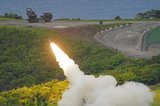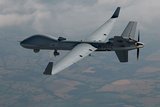SUAV precision strike capability demonstrated
General Dynamics Ordnance and Tactical Systems has announced that along with the US Army Armament Research and Development Engineering Center (ARDEC), it has successfully demonstrated a GPS-guided munition for use on small Unmanned Aerial Vehicles (SUAVs).
According to the company, recent testing was conducted in which three mortars were launched from a UAV at altitudes of approximately 7,000 ft and guided to within seven meters of a GPS-identified target grid. The three separate engagements used a Tiger Shark UAV launching an 81mm mortar equipped with General Dynamics' Roll Control Fixed Canard (RCFC) control system and an ARDEC-developed fuzing solution.
The tests were part of the Air Drop Mortar (ADM) programme, which is designed to meet the needs of the US Army, Marine Corps and Special Forces for a rapid target response capability. According to the company, the ADM uses existing mortar inventory to provide a low-cost, lightweight weapon system with proven energetics. The RCFC guidance kit, with an innovative flight-control and GPS-based guidance and navigational system, adds precision-strike capability to existing mortars. The nose-mounted guidance kit replaces existing mortar fuzes and has been successfully demonstrated on multiple mortar calibres in both air-drop and tube-launch applications. The kit provides a common, multi-platform Guidance, Navigation and Control (GNC) and integrated weapon system for UAVs.
Mark Schneider, general manager of General Dynamics Ordnance and Tactical Systems' Seattle operations, said: ‘This effort demonstrated a low-cost, tactical version of a GPS strike weapon for UAV platforms. Together with ARDEC, we have demonstrated a weapon in the 10-pound class for tactical UAVs that can be used to quickly engage and defeat targets. Advancements in GPS targeting and data-link technology provide a built-in growth path for this demonstrated technology.’
Tony Sebasto, senior associate for Munitions at ARDEC, added: ‘The ADM programme with General Dynamics provided a platform to successfully demonstrate and mature subsystems including communication links, munition deployment, guidance and control and fuzing. The utilization of existing mortar production components, along with demonstrated guidance and control and fuzing, gives the US warfighter an option for a very affordable and very capable precision strike weapon.’
More from Uncrewed Vehicles
-
![What's next for the Pentagon after the Replicator programme?]()
What's next for the Pentagon after the Replicator programme?
Although the Replicator initiative has made several accomplishments, there are still multiple gaps to plug across the US Department of Defense (DoD) and its services.
-
![Cummings Aerospace showcases Hellhound loitering munition designed for US Army’s LASSO programme (video)]()
Cummings Aerospace showcases Hellhound loitering munition designed for US Army’s LASSO programme (video)
Cummings Aerospace presented its turbojet-powered Hellhound loitering munition at SOF Week 2025, offering a man-portable solution aligned with the US Army’s LASSO requirements.
-
![SOF Week 2025: PDW unveils attritable FPV drone for SOF operations at scale]()
SOF Week 2025: PDW unveils attritable FPV drone for SOF operations at scale
PDW has revealed its Attritable Multirotor First Person View drone at SOF Week 2025, offering special operations forces a low-cost, rapidly deployable platform for strike and ISR missions, inspired by battlefield lessons from Ukraine.
-
![SOF Week 2025: Teledyne FLIR white paper provides guidance on reusable loitering munitions]()
SOF Week 2025: Teledyne FLIR white paper provides guidance on reusable loitering munitions
Teledyne FLIR is highlighting the emerging requirements for 'recoverable and re-usable' loitering munitions across the contemporary operating environment during this week’s SOF Week conference in Tampa, Florida.
-
![SOF Week 2025: Kraken Technology group debuts K3 Scout USV in North America]()
SOF Week 2025: Kraken Technology group debuts K3 Scout USV in North America
High-performance maritime industry player Kraken Technology Group, based in the UK, has used the SOF Week conference in Tampa, Florida this week to debut its K3 Scout uncrewed surface vessel (USV) to the North American market.
-
![Palladyne AI and Red Cat to demonstrate capabilities for autonomous drone swarms to the US military]()
Palladyne AI and Red Cat to demonstrate capabilities for autonomous drone swarms to the US military
Red Cat and Palladyne AI recently conducted a cross-platform collaborative flight involving three diverse heterogeneous drones.

























